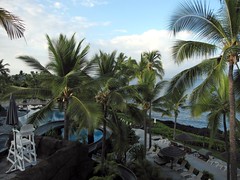 We woke up on Thursday to find that our "garden view" hotel room actually overlooked the pool, with the ocean in the distance. The hotel's two pools were large and connected, with grottos, kiddie beaches, and a water slide. Very impressive. Unfortunately, we didn't have time to enjoy it. More on the hotel in a later entry.
We woke up on Thursday to find that our "garden view" hotel room actually overlooked the pool, with the ocean in the distance. The hotel's two pools were large and connected, with grottos, kiddie beaches, and a water slide. Very impressive. Unfortunately, we didn't have time to enjoy it. More on the hotel in a later entry.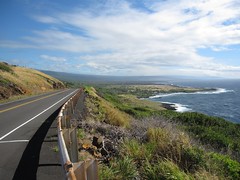 After grabbing coffee and a muffin, we left for Hawaii Volcanoes National Park, a third of the way around the island on the south side. Even though it was only 80 miles, it would take about two hours to drive there. The road is only two lanes, with some towns and winding sections. We were delayed at the start by the traffic jam going into the school, but made pretty good time once we got through the first 30 slow miles. There are some very scenic parts of this drive, especially northeast of Naalehu, and not much else.
After grabbing coffee and a muffin, we left for Hawaii Volcanoes National Park, a third of the way around the island on the south side. Even though it was only 80 miles, it would take about two hours to drive there. The road is only two lanes, with some towns and winding sections. We were delayed at the start by the traffic jam going into the school, but made pretty good time once we got through the first 30 slow miles. There are some very scenic parts of this drive, especially northeast of Naalehu, and not much else.The weather was looking good until we reached the park entrance, at about 4000 feet above sea level. The most popular part of the park rests on the southeast shoulder of Mauna Loa, stretching from the area around Kilauea Caldera down to the ocean. This shoulder, combined with the predominant northeast winds, means that it is rainy and tropical on the east side (and on top), and dry and desert-like on the west side (which we just drove through). We brought our raincoats, but only shorts and no change of clothes. I hoped we wouldn't get too cold or wet.
An unfortunate part of our trip was that we were only spending two full days on the big island. One of those days would be for seeing the volcano, and we knew that wasn't really long enough to give it a fair shake, but we would at least get a taste of it. The more accessible part of the park is a road around the Kilauea Caldera (Crater Rim Drive), and a road that threads south towards the ocean, through a series of old crater sites on the way (Chain of Craters Road). Here is a map. (1.8MB PDF) However, half of Crater Rim Drive was closed due to volcanic activity in the caldera, which was spewing toxic fumes in the air, so the tour was mostly reduced to an out-and-back trip. Aside from the Kilauea Caldera activity, there was also an active eruption at the Pu'u 'O'o site on the eastern edge of the park. This area was also closed, but it was a long hike from the road as well, so we were never going to have a chance of seeing it anyways. There was some lava flowing into the ocean from Pu'o 'O'o, but the best (and only officially sanctioned viewing spot) was outside the park and accessed from the east side in Kalapana, which is about an hour's drive. This meant we had to plan to get out of the park by about 4:30 at the latest, since the sun set at about 6:30, and we wanted to get to the lava viewing before then. My plan was to start at the entrance and work our way down to the ocean, seeing the sights along the way. Then we'd leave for Kalapana.
It was almost 11 AM when we arrived. After picking up some lunch items at the Volcano general store, we stopped at the park visitor center, where we learned that there would be a ranger-guided hike around and through Kilauea Iki Crater at 1:00. This was a hike we wanted to do anyways, since it was a chance to get out and explore some stuff in only a couple of hours, so we rearranged our schedule to be back at that time.
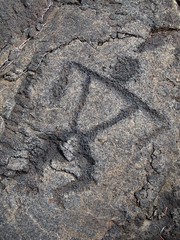 We first drove most of the way to the end of the Chain of Craters Road, and the weather cleared up nicely as we approached the ocean. There is a cliff along the way, which is covered with the remnants of lava flows from the 1970s. We stopped at the Pu'u Loa Petroglyphs. Here, each generation of the ancient Hawai'ians would carve symbols in the lava rocks and deposit the piko (umbilical cord) of their kids in the pukas (holes), hoping that the spirits would bless their child with a long and prosperous life. This is supposedly one of the largest and most concentrated areas of petroglyphs in Hawaii.
We first drove most of the way to the end of the Chain of Craters Road, and the weather cleared up nicely as we approached the ocean. There is a cliff along the way, which is covered with the remnants of lava flows from the 1970s. We stopped at the Pu'u Loa Petroglyphs. Here, each generation of the ancient Hawai'ians would carve symbols in the lava rocks and deposit the piko (umbilical cord) of their kids in the pukas (holes), hoping that the spirits would bless their child with a long and prosperous life. This is supposedly one of the largest and most concentrated areas of petroglyphs in Hawaii.After viewing the petroglyphs, we worked our way back towards the Kilauea Iki. We stopped at a few of the old craters, and checked out the Thurston Lava Tube, a big tunnel formed by hot lava during a previous eruption. We got to the trailhead to meet the park ranger for the tour just before 1PM... and it started raining.
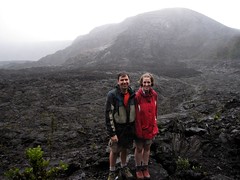 We joked with the park ranger about how great a day it was for a hike, and he agreed (seriously) that it was a better than average day, since it wasn't a torrential downpour. Like I was saying, I guess it rains a lot there. We did get pretty wet over the next few hours, but the ranger still wove some good stories. It eventually stopped, and even cleared up a bit, as we entered the crater for the return half of the loop. The ranger did have some interesting talks, explaining the different types of volcanoes found around the world, the difference between indigenous and endemic species in Hawaii, and describing the Kilauea Iki eruption of 1959, where lava spewed hundreds of meters in the air. Nothing that exciting was happening on the day we were there, but we did get to walk on the surface of an active volcano, and the steam vents were still satisfyingly steamy.
We joked with the park ranger about how great a day it was for a hike, and he agreed (seriously) that it was a better than average day, since it wasn't a torrential downpour. Like I was saying, I guess it rains a lot there. We did get pretty wet over the next few hours, but the ranger still wove some good stories. It eventually stopped, and even cleared up a bit, as we entered the crater for the return half of the loop. The ranger did have some interesting talks, explaining the different types of volcanoes found around the world, the difference between indigenous and endemic species in Hawaii, and describing the Kilauea Iki eruption of 1959, where lava spewed hundreds of meters in the air. Nothing that exciting was happening on the day we were there, but we did get to walk on the surface of an active volcano, and the steam vents were still satisfyingly steamy.Our guided tour wrapped up at about 3:30 or 4, and we had to make a decision about what to do before heading for the lava viewing. We ended up leaving right away since we weren't sure exactly how long it would take to get there. We got most of the way to Hilo (where we had to turn right to head south to the viewing area) faster than we expected, so we tried to go to the Lava Tree State Park. The park is mostly gardens and some lava formations. As soon as we got there, it started raining again, and it was a torrential rain that made us wonder if we'd get to see anything at the lava viewing. We ran back to the car, and we slowly made our way south. Driving was difficult in the heavy rain, but it stopped by the time we got to the coast.
The towns of Kalapana and Kaimu were pretty much destroyed in the lava flow of 1990. The former state highway, which previously connected with the end of Chain of Craters Road (in the National Park) was overrun with lava and severed, and now the state highway on the east side serves as the access road to the lava viewing area. Some parts of the access road were covered with lava, which were crudely graded and paved over with a single lane of asphalt. A few houses were luckily spared here, and people still live there. One property was for sale -- not sure if it's a good deal regardless of the price. The road finally ends in an improvised park area, where the local government has tried to bring some order to what surely used to be chaos. There are parking attendants, a series of vendor tents hawking fruit, photography and flashlights, and an information booth.
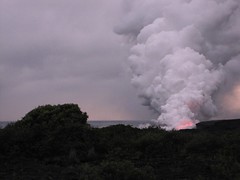 Once you have parked, there is an almost half-mile walk over old lava flows to get to the viewing area near the shore. Reflective pylons and tape are used to try to guide people along the way, which would obviously be difficult to do in the dark. The actual viewing area is predictably disappointing, since it is at least another quarter-mile from the action, with screaming kids and mobs of people jockeying for photo position. All you can really see is a giant plume of steam, with a red glowing area and an occasional explosion of lava into the air. I don't know how to describe it, it sounds boring, but it is really a unique and captivating experience. We were mesmerized for about 45 minutes, until it was dark, and made our way back to the car. It was interesting to see the side of the mountain glowing red in spots, as the lava flowed down from Pu'o 'O'o.
Once you have parked, there is an almost half-mile walk over old lava flows to get to the viewing area near the shore. Reflective pylons and tape are used to try to guide people along the way, which would obviously be difficult to do in the dark. The actual viewing area is predictably disappointing, since it is at least another quarter-mile from the action, with screaming kids and mobs of people jockeying for photo position. All you can really see is a giant plume of steam, with a red glowing area and an occasional explosion of lava into the air. I don't know how to describe it, it sounds boring, but it is really a unique and captivating experience. We were mesmerized for about 45 minutes, until it was dark, and made our way back to the car. It was interesting to see the side of the mountain glowing red in spots, as the lava flowed down from Pu'o 'O'o.For dinner, we stopped at Kaleo's in Pahoa. It's off the main road in the town center, but not out of the way, and worth the trip. There was a good jazz trio playing, featuring three multi-talented musicians: keyboard/bass (keyboard)/vocals, alto sax/soprano sax/flute, and drums/chairs/walls. The menu was modern and original, the food was fresh and well-prepared, and it was all very reasonably priced. I think I had a grilled ahi entree with rice and tasty grilled veggies, and E had a Thai chicken curry of some sort. For dessert we had a really tasty banana thing where the bananas were fried in tortillas and topped with a cinnamon sauce and vanilla ice cream. Thanks to C+K for the tip, this place was great!
The only downside was that we were still almost 3 hours from "home". It was a long and lonely trip, with little traffic, spotty radio, and a sleeping passenger. Still being a bit jet-lagged, I probably should have gotten some coffee to go, but it didn't occur to me until it was too late. We stopped at least once to walk around the car, to try to stay fresh. It was good to finally get back to the hotel and crash.
This was a good day, but if I had to do it again, I would try to spend at least two days in the park area, or if I were really pressed for time again, try to find a way to stay in Hilo (or one of the small inns in the town of Volcano) so less time is spent driving. I would also love to get a closer view of the active lava flows, which is obviously discouraged by the authorities, but not illegal, as far as I can tell. It seems feasible, as long as you take some reasonable precautions.
Future postings will mostly be shorter than this. I hope. I mean, there's only so much I can write about the Honolulu Airport, but we'll see. Am I blogging or writing my memoirs?

1 comment:
Hey, sounds like you had a good volcano experience, all in all. I'm glad you stopped at Kaleo's! I keep meaning to tell Frommer's about it. It's definitely worth adding to the book.
Post a Comment